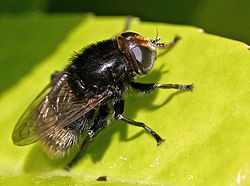| Merodon | |
|---|---|
 | |
| Merodon equestris the Narcissus bulb fly | |
| Scientific classification | |
| Kingdom: | Animalia |
| Phylum: | Arthropoda |
| Class: | Insecta |
| Order: | Diptera |
| Family: | Syrphidae |
| Subfamily: | Eristalinae |
| Tribe: | Eumerini |
| Genus: | Merodon Meigen, 1803 |
| Synonyms [1] | |
Merodon is a large genus of bee-like hoverflies. The majority of the species are centered on the Mediterranean and it is the second largest hoverfly genus in Europe with more than 50 European species. It is distributed over the Palaearctic and Afrotropical realms, with most European species occurring in Southern and Eastern Europe. The centre of distribution of this genus appears to be Turkey, where about 65 species have been recorded. Some species occur in Africa (Morocco through East Africa and Ghana to South Africa) and the middle East, as far as Pakistan. Given the rate at which new species have been recorded over the past decades, the worldwide number of species could exceed 200. The larvae feed on the bulbs or rhizomes of monocotyledons.
Contents

One of the more common species in the genus, Merodon equestris is known as the Narcissus bulb fly, greater bulb-fly, large bulb fly or large Narcissus fly.